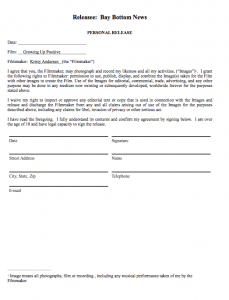The Release
When you work on a film you are not under an obligation to make it legal until you plan to distribute or sell it. In fact, most of the time you can work with materials that are “screeners” or place keepers. These are usually low-end materials that enable you to work with your visuals on your Fine Cut, until you are ready to pay for rights to the materials so you can distribute or sell your film. Film footage is available with a per-second control track embedded in the footage, making the footage identifiable to the archival house.
When you film an interview, you should get a release.  I jokingly tell people that a release gives me all the rights and they get none – and this is the truth. Remember that eventually you will want to distribute your work, either on your own or by selling it to someone else. You have to be able to offer your distributor a film that is free and clear. If not then the distributor will not be willing to take a chance on the distribution.
I jokingly tell people that a release gives me all the rights and they get none – and this is the truth. Remember that eventually you will want to distribute your work, either on your own or by selling it to someone else. You have to be able to offer your distributor a film that is free and clear. If not then the distributor will not be willing to take a chance on the distribution.
No matter how thoroughly you clear rights, you will still need to buy Errors and Omissions Insurance (E&O). That is insurance that will cover you and the distributor in case someone sues because you did not get a release or get other rights you needed, or because those who gave you the rights did not actually own the rights. An E&O insurance policy usually lasts only for 3-4 years from initial broadcast because generally, if someone is going to sue you, they will do so within that amount of time. The cost of your insurance policy will reflect how thoroughly you have cleared your film – whether you have a release for every person in your film, cleared rights for every photo, every piece of film footage, every piece of music. A general rule of thumb is that you need a release for every person who is on-screen – even in crowd shots. If you are dealing with “life rights” or rights to someone’s life story, you will need to clear those rights with the copyright owners, as well. Keep in mind that if someone has already obtained life rights, you might be out of luck, unless they have expired. You might also be asked for Work Agreements from photographers or editors that pass on their artistic rights to you, the producer. So be sure to get those as you move the project along.
I bought an E&O insurance policy for a film and it cost me $4500. And that was after I’d cleared everything! It would have cost more if I had not cleared materials or obtained releases. You will need to include the cost of E&O insurance when you determine how much you need to ask when you sell your film, so you can pay for rights.
There are other samples of releases available on the internet, and sometimes a distributor will want you to use their particular form.


